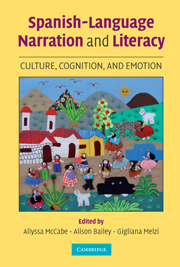PART ONE - PARENT–CHILD NARRATIVES
Published online by Cambridge University Press: 05 June 2012
Summary
Children develop narrative abilities through the interactions they have with others on a daily basis. The conversations shared between caregivers and children during these interactions serve as a primary sociolinguistic context in which children gain mastery of the skills necessary to produce and share a coherent story in later years. The language used during these conversations both reflects cultural norms and serves to socialize children into culture-specific practices (Ochs & Capps, 2001; Schieffelin & Ochs, 1986).
Interest in family narrative practices across cultures has increased in the last few decades and studies from various disciplines have contributed to our understanding of the multiple ways in which children across the world develop narrative skills (e.g., Fivush & Haden, 2003; Ochs & Capps, 2001). Despite this interest, however, few studies have investigated Latino families' narrative interactions (e.g., Eisenberg, 1985; Schecter & Bayley, 2002; Torres, 1997) and, to our knowledge, even fewer have gone beyond U.S. borders. The first five chapters of this volume address these gaps by examining the multiple ways in which Latin American and U.S. Latino parents contribute to their children's development.
In chapter 2, Caspe and Melzi examine how mothers from three different countries – Peru, Puerto Rico, and the United States– share a wordless book and support their 3-year-olds' participation in the creation of the story. Like personal narrative conversations, book-sharing interactions constitute an everyday context in which mothers and children share stories together.
- Type
- Chapter
- Information
- Spanish-Language Narration and LiteracyCulture, Cognition, and Emotion, pp. 3 - 5Publisher: Cambridge University PressPrint publication year: 2008

